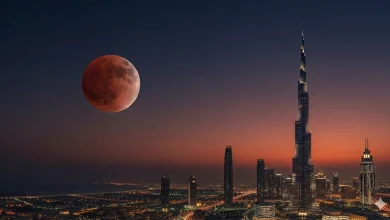
Al Habtoor Tower Chooses Empower Dubai for Groundbreaking Cooling Contract
Empower Dubai, renowned as the world’s largest provider of district cooling services, recently entered a significant agreement with Al Habtoor Group. This partnership marks a pivotal step for both entities, as Empower is set to supply Al Habtoor Tower with its cutting-edge cooling systems, underscoring the expanding footprint of district cooling projects in Dubai.
This contract was formalized at Al Habtoor Group’s headquarters, a momentous occasion witnessed by HE Ahmad bin Shafar, CEO of Empower, and Mr. Mohammed Khalaf Al-Habtoor, Vice Chairman & CEO of Al Habtoor Group. This collaboration not only highlights Empower’s leading role in enhancing cooling services but also sets a new benchmark for sustainable and efficient cooling solutions in the region’s real estate sector.
Al Habtoor Tower: An Iconic Addition to Dubai
Tower Overview
Al Habtoor Tower Specifications:
- Height: 350 meters
- Floors: 87
- Total Area: 3,517,313 square feet
- Residential Units: 1,701
- Expected Residents: Over 5,000
Architectural and Design Features
- Builder: China Railway 18th Bureau Group Ltd
- Design: Original geometric shape and memorable design
- Location: Nestled along the Dubai Water Canal, Al Habtoor City
Amenities and Lifestyle
- Luxury Elements: Ultra-luxurious living spaces, infinity pool, state-of-the-art gym, library, padel courts
- Additional Facilities: Retail outlets, dining options, health care centre, kids play area, parks, and leisure areas.
Accessibility and Local Attractions
- Proximity to Key Locations:
- Downtown Dubai – 10 minutes
- Dubai Opera – 10 minutes
- City Walk – 10 minutes.
Residential Options and Pricing
- Apartment Types: 1, 2, and 3-bedroom apartments with private pools and balconies
- Starting Price: AED 1,700,000
- Payment Plan: 20% at booking, 10% during construction, 50% under-construction, 40% on handover
This strategic addition to Dubai’s skyline not only enhances the city’s architectural aesthetics but also promises an elevated lifestyle with its comprehensive suite of luxury amenities and prime location.
Empower’s District Cooling Solution
Overview of Empower’s District Cooling Systems
Empower’s innovative district cooling solutions are designed to meet the diverse needs of large-scale developments like Al Habtoor Tower. Utilizing a network of underground insulated pipes, the system efficiently distributes chilled water to residential and commercial facilities, significantly reducing energy consumption and operational costs.
Key Components and Infrastructure
- Thermal Energy Plant: Central production facility that generates the cooling required.
- Distribution Piping Network (DPN): Ensures efficient transport of chilled water to various buildings.
- End-User Interfaces: Connects the internal cooling systems of buildings to the district cooling network.
Strategic Developments and Capacity
- Expansion of Facilities: Following the acquisition of 19 cooling plants from Nakheel, Empower now serves over 18,000 customers across 17 major projects in Dubai.
- Investment in Dubai Maritime City: Empower plans to invest AED 450 million to supply cooling services to more than 43 buildings, showcasing significant growth in their operational capabilities.
Technological Innovations and Sustainability Efforts
- Adoption of Reverse Osmosis (RO) Technologies: These technologies purify water for reuse in cooling operations, helping save 412 million imperial gallons of fresh water annually.
- Energy Efficiency: District cooling systems consume 40-50% less energy per refrigeration ton-hour compared to traditional cooling technologies.
Empower’s Commitment to Environmental and Economic Sustainability
- Reduction in CO2 Emissions: Empower’s operations led to an annual CO2 saving of approximately 735,000 tCO2 in 2021.
- Future Goals: By 2050, Empower aims to operate carbon-neutral cooling plants, significantly contributing to the Dubai Energy Transition plan.
Empower’s district cooling solutions not only offer superior efficiency and environmental benefits but also align with global sustainability goals, making them a pivotal element in modern urban development.
The Environmental and Economic Impact
Energy Efficiency and Cost Savings
District cooling systems, as implemented by Empower, significantly enhance energy efficiency by optimizing cooling production and utilizing advanced technologies. This approach not only meets the cooling demands efficiently but also contributes to substantial energy savings.
- Reduced Energy Consumption: District cooling systems use 40-50% less energy compared to traditional air conditioners, offering a sustainable solution for large-scale cooling needs.
- Long-term Cost Efficiency: These systems are not only energy-efficient but also cost-effective over their operational lifespan, which can extend up to 30 years.
Environmental Benefits
The adoption of district cooling technology has profound environmental impacts, reducing the carbon footprint of urban development’s significantly.
- Lower Greenhouse Gas Emissions: By minimizing the use of hydrofluorocarbons and optimizing electrical loads, district cooling systems substantially reduce greenhouse gas emissions.
- Noise Reduction: These systems operate silently, enhancing comfort without the disruptive noise associated with conventional cooling methods.
Enhanced Building Value and Space Utilization
District cooling contributes to increasing the value of properties by providing reliable and efficient cooling solutions, which are increasingly valued in real estate markets.
- Space Efficiency: The compact nature of district cooling substations frees up valuable building space, which can be utilized for other purposes, enhancing the functionality and aesthetics of properties.
- Architectural Benefits: Eliminating the need for conventional cooling units on rooftops allows for more creative and appealing architectural designs.
Sustainability and Innovation
Empower’s commitment to sustainability is evident in its strategic use of renewable energy sources and innovative technologies in district cooling systems.
- Use of Renewable Energy: Exploring solar power and other renewable sources to operate cooling plants aligns with global sustainability goals and reduces dependence on fossil fuels.
- Innovative Cooling Technologies: Implementing waste heat recovery and thermal energy storage further enhances the efficiency and environmental friendliness of these systems.
This comprehensive approach not only supports Dubai’s Energy Transition plan but also sets a benchmark for sustainable urban development globally.
Future Developments and Strategic Implications
Strategic Expansion and Technological Integration
Planned Infrastructure Enhancements
Empower is set to significantly increase its operational capacity, with plans to expand district cooling capacity from 1.3 million refrigeration tons to 2.3 million by 2030. This expansion is crucial to accommodate the growing demand for efficient cooling solutions in Dubai’s rapidly developing urban landscape.
Landfill Gas Power Plant Project
In a pioneering move, Empower is exploring the development of a landfill gas power plant. This initiative aims to harness methane from landfills for power generation, reducing reliance on conventional energy sources and enhancing sustainability.
Regulatory and Market Developments
New Regulations for District Cooling
The introduction of stringent regulations will standardize operations across the district cooling sector. These regulations are designed to ensure service quality, fair pricing, and adherence to safety and maintenance standards, which are critical for long-term sustainability and consumer protection.
Growth in the Industrial Sector
The industrial sector is poised for significant growth, driven by the adoption of district cooling systems in areas such as oil & gas and manufacturing. This expansion is supported by technological advancements that optimize cooling efficiency and sustainability.
Technological Advancements and Smart Integration
Smart Technologies for Enhanced Efficiency
The integration of AI, IoT, and smart grids is transforming the operational efficiency of district cooling systems. These technologies enable real-time monitoring and management, ensuring optimal performance and energy conservation.
Innovations in Cooling Technology
Advancements such as adsorption chillers and smart control systems are being incorporated to enhance the efficiency of district cooling networks. These innovations are crucial for supporting smart city initiatives in Dubai and beyond.
Market Dynamics and Future Outlook
Projected Market Growth
The UAE’s district cooling market is expected to witness substantial growth, with a projected CAGR of 7.5% from 2020 to 2027. This growth is driven by increased infrastructure spending and the escalating need for sustainable cooling solutions.
Expansion in MENA Region
While Dubai leads in district cooling implementation, other MENA countries are increasingly recognizing the benefits of this technology. Challenges such as high initial costs and regulatory barriers are being addressed to facilitate wider adoption in the region.
The groundbreaking agreement between Empower Dubai and Al Habtoor Group to supply Al Habtoor Tower with cutting-edge cooling solutions marks a significant milestone in the evolution of district cooling technologies in Dubai. This pact not only sets a new benchmark in sustainable and efficient cooling but also showcases Empower’s commitment to enhancing the environmental and economic landscape of urban development. The implementation of such innovative systems in iconic developments like Al Habtoor Tower demonstrates the transformative potential of district cooling solutions in reducing energy consumption and operational costs while promoting a more sustainable approach to urban living.
As the world moves towards greener and more efficient energy solutions, the collaboration between these two giants is a testament to Dubai’s leadership in adopting and promoting sustainable practices across its thriving real estate sector. The broader implications of this strategic move extend beyond immediate energy efficiency and cost savings, promising enhanced property values, architectural freedom, and notably, a significant reduction in the city’s carbon footprint. This initiative not only aligns with global sustainability goals but also sets a compelling example for future urban development projects worldwide, underlining the importance of environmental consciousness in the face of rapid urbanization.







[…] British Protection Era […]